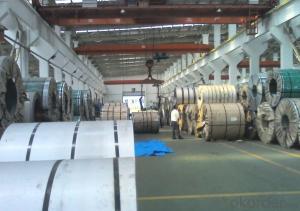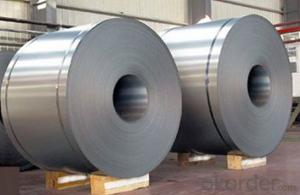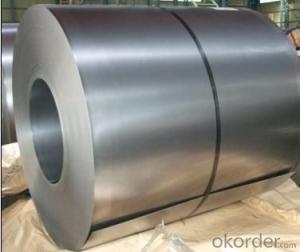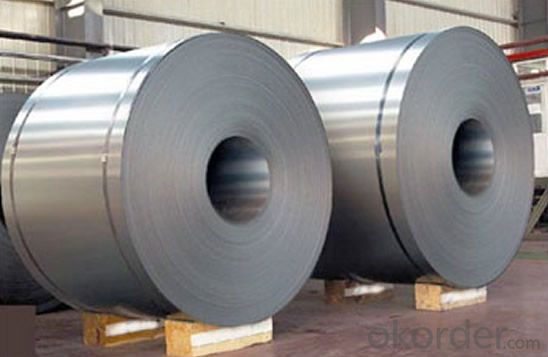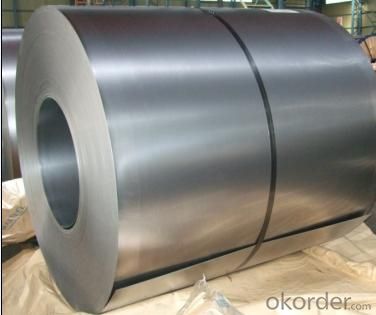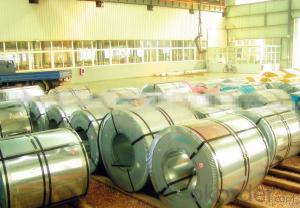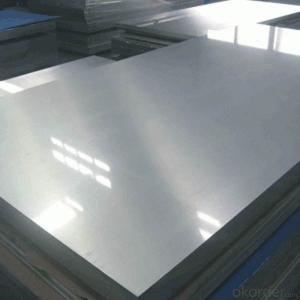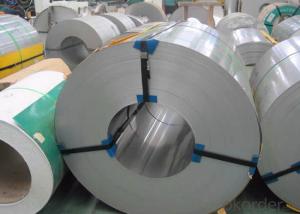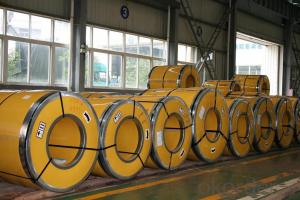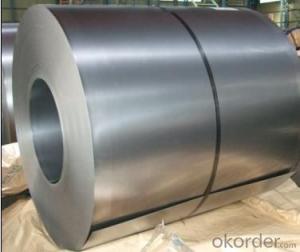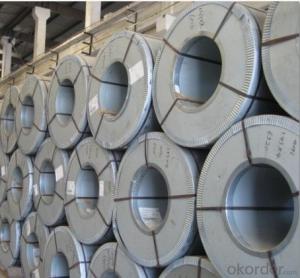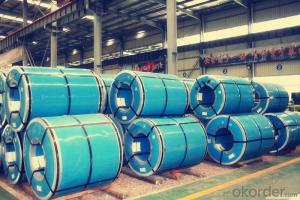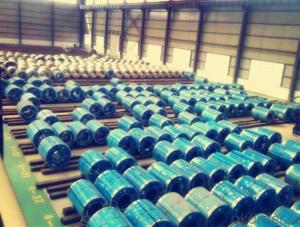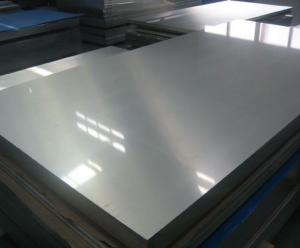Stainless Steel Coil/Sheet/Strip 304 Hot/Cold Rolled 2B/BA/NO.1
- Loading Port:
- Guangzhou
- Payment Terms:
- TT OR LC
- Min Order Qty:
- 100 m.t.
- Supply Capability:
- 20000 m.t./month
OKorder Service Pledge
OKorder Financial Service
You Might Also Like
Hot Rolled Stainless Steel Coil 304
Stainless steel is a production which not easy rust,acid resistance and corrosion resistance,so it is widely
used in light industry,heavy industry,daily necessities and the decoration industry.
Hot Rolled Stainless Steel Coil 304 Specifications
1.surface:NO.1
2.standard:JIS, AISI, GB
3.width: 0.55m, 0.65m, 1.0m, 1.22m, 1.5m, 2m or requirement
Hot Rolled Stainless Steel Coil 304 Chemical Composition:
(%):C=0.07, Mn=2.00, P=0.045, S=0.030, Si=0.075, Cr=17.5-19.5, Ni=8.0-10.5, N=0.10
Hot Rolled Stainless Steel Coil 304 Physical Properties
Tensile strength σb (MPa) ≥ 520
the conditions yield strength σ0.2 (MPa) ≥ 205,
elongation δ5 (%) ≥ 40
Reduction of ψ (%) ≥ 50,
hardness: ≤ 187
HB; ≤ 90
HRB; ≤ 200H
- Q: Are stainless steel strips resistant to hydrogen embrittlement?
- Yes, stainless steel strips are generally resistant to hydrogen embrittlement. Stainless steel is known for its excellent corrosion resistance, and this property also extends to its resistance against hydrogen embrittlement. Hydrogen embrittlement is a phenomenon where hydrogen atoms penetrate the steel's crystal lattice, causing it to become brittle and susceptible to cracking or failure. However, stainless steel contains a high amount of chromium, which forms a passive oxide layer on its surface. This oxide layer acts as a protective barrier, preventing hydrogen atoms from diffusing into the steel and reducing the risk of embrittlement. Additionally, stainless steel strips are often made with austenitic grades, which have a high nickel content that further enhances their resistance to hydrogen embrittlement.
- Q: What is the electrical conductivity of stainless steel strips?
- The electrical conductivity of stainless steel strips can vary depending on the specific type and composition of stainless steel. Generally, stainless steel is not as conductive as other metals like copper or aluminum. The electrical conductivity of stainless steel is typically lower due to its higher resistance to the flow of electric current. However, there are stainless steel alloys that have been specifically designed for improved electrical conductivity. These alloys often contain higher levels of elements like nickel or copper, which enhance the material's conductivity. It is important to note that the electrical conductivity of stainless steel can also be affected by factors such as temperature, surface condition, and thickness of the strip. Therefore, it is advisable to refer to specific data or consult with manufacturers for accurate information on the electrical conductivity of stainless steel strips.
- Q: How do stainless steel strips resist erosion in abrasive environments?
- Stainless steel strips resist erosion in abrasive environments due to their unique composition and protective oxide layer. The high levels of chromium present in stainless steel form a passive film on the surface, which acts as a barrier against corrosion and prevents direct contact of the metal with the abrasive materials. This oxide layer is self-healing, meaning it can repair itself if damaged, further enhancing the steel's resistance to erosion. Additionally, stainless steel's high strength and hardness make it more resistant to wear and tear, allowing it to withstand the abrasive forces present in harsh environments.
- Q: How does stainless steel strip perform in corrosive environments?
- Stainless steel strip performs exceptionally well in corrosive environments due to its inherent resistance to corrosion. The presence of chromium in stainless steel forms a passive layer on the surface, which acts as a protective barrier against corrosive agents. This characteristic makes stainless steel strip highly durable and reliable in various corrosive conditions, ensuring minimal or no degradation over time.
- Q: What are the different types of surface treatments for stainless steel strips?
- There are several types of surface treatments for stainless steel strips, including passivation, pickling, electro-polishing, and coating. Passivation involves removing any contaminants from the surface to prevent corrosion. Pickling is a chemical treatment that removes impurities and enhances the appearance. Electro-polishing is an electrolytic process that smooths the surface and improves corrosion resistance. Coating involves applying a protective layer to the surface, such as a polymer or metal, to enhance durability and aesthetics.
- Q: What are the different packaging options for stainless steel strips?
- Stainless steel strips have various packaging options available to cater to the specific requirements and preferences of customers: 1. Coils: Coils are tightly wound stainless steel strips that are secured with straps or plastic wrap. They offer easy handling, transportation, and storage, making them efficient for large quantities. 2. Wooden Crates: For enhanced protection and durability, stainless steel strips can be packed neatly in wooden crates. Straps or foam inserts are used to secure the strips, preventing damage during shipping or storage. Wooden crates are commonly used for heavy-duty applications or long-term storage. 3. Pallets: Stainless steel strips can also be packaged on pallets, where they are stacked and secured with bands or shrink wrap. This option allows for convenient handling using forklifts and ensures stability during transportation. Pallets are suitable for smaller quantities of strips. 4. Bundles: Bundling stainless steel strips together using plastic or steel bands keeps them organized and secure, preventing tangling or damage. Bundles are ideal for smaller quantities, offering easy handling and storage. 5. Custom Packaging: Custom options for packaging stainless steel strips can be tailored to specific customer needs. This may involve adding protective covers, foam inserts, or custom labeling for easy identification. Custom packaging ensures adequate protection and readiness for use upon delivery. In conclusion, the packaging options for stainless steel strips vary depending on factors such as quantity, transportation requirements, and desired level of protection. Manufacturers and suppliers collaborate closely with customers to determine the most suitable packaging option, ensuring the safe and efficient delivery of stainless steel strips.
- Q: What is the toughness of stainless steel strips?
- Stainless steel strips possess remarkable toughness, known for their ability to endure substantial stress and resist deformation or breakage in extreme circumstances. This is attributable to the distinct characteristics of stainless steel, which include its formidable tensile strength and exceptional resistance to impact. In sectors that demand resilience and sturdiness, such as construction, automotive, and aerospace industries, stainless steel strips are frequently employed. They exhibit the capacity to withstand heavy loads, combat corrosion, and uphold their structural integrity even in harsh surroundings. Consequently, stainless steel strips are widely esteemed for their durability and dependability, rendering them a favored option across diverse industries.
- Q: Are stainless steel strips suitable for high-temperature applications?
- Yes, stainless steel strips are suitable for high-temperature applications. Stainless steel has excellent heat resistance properties, making it highly resistant to oxidation and corrosion at elevated temperatures. It retains its strength and structural integrity even at high temperatures, making it ideal for use in various industries such as automotive, aerospace, and energy. Additionally, stainless steel strips have thermal stability and low thermal expansion, enabling them to withstand thermal cycling and maintain dimensional stability. Moreover, stainless steel's high melting point makes it suitable for applications that require exposure to extreme heat. Overall, stainless steel strips are a reliable choice for high-temperature applications due to their exceptional heat resistance properties.
- Q: Are 111 stainless steel strips suitable for harsh chemical environments?
- No, 111 stainless steel strips are not suitable for harsh chemical environments.
- Q: How do stainless steel strips perform in high temperature environments?
- Stainless steel strips perform exceptionally well in high temperature environments due to their excellent heat resistance properties. They maintain their strength and structural integrity, without deformation or warping, even under extreme heat conditions. This makes stainless steel strips a reliable choice for various applications in industries like aerospace, power generation, and automotive, where high temperatures are prevalent.
Send your message to us
Stainless Steel Coil/Sheet/Strip 304 Hot/Cold Rolled 2B/BA/NO.1
- Loading Port:
- Guangzhou
- Payment Terms:
- TT OR LC
- Min Order Qty:
- 100 m.t.
- Supply Capability:
- 20000 m.t./month
OKorder Service Pledge
OKorder Financial Service
Similar products
Hot products
Hot Searches
Related keywords

